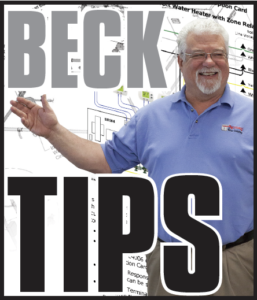 By Ron Beck, Outside Technical Advisor and Manager of Training for U.S. Boiler Company
By Ron Beck, Outside Technical Advisor and Manager of Training for U.S. Boiler Company
The phone rings and the voice on the other end of the line says, “This is Mr. Homeowner, and I’d like an estimate on a new boiler… when would you be available to give me a quote?”
You show up for the appointment, introduce yourself, offer a business card, make small talk and head to the basement. After writing down all the pertinent information, you head upstairs and measure the fin-tube baseboard.
A rough calculation tells you the home is about 1,800 square feet. You also notice the newer windows and doors.
Upon returning to the office, you start to work on the quote. According to your notes, the old boiler is 125,000 BTU/hr. You multiply the lineal feet of radiation by 590 BTU/hr, and find the connected load is about 110,000 BTU/hr. What to do?
The customer said the old boiler heated the home “okay,” so you decide to match the old boiler’s size. Since the customer asked for an Alpine high efficiency condensing gas boiler, you review the product data sheet and discover that the closest Alpine models are 105,000 and 150,000 BTU/hr. You choose the ALP150, calculate the installation and labor costs, the customer signs the proposal, and the boiler is installed.
A month later you receive another call from Mr. Homeowner claiming that the boiler is short-cycling. You explain that the boiler is roughly the same size as the old unit. The customer says he’s been surfing the web and wants to know what the result of your heat loss calculation was. You respond with, “I’ve been doing this a long time and do not need to perform a heat loss.”
You send a technician out and they check the boiler’s run time hours and number of cycles. They find that the average run time is three minutes. You know that a short-cycling boiler increases fuel consumption and is hard on the control and fan. The customer is aware of this as well.
The homeowner has a heat loss done by another firm, resulting in 70,000 BTU/hr. He shows up at your office, hands you the calculation, and asks what you are going to do about the oversized boiler. What would your response be?
Unfortunately, many boilers are oversized. Prior to any boiler installation, a heat loss should be performed and the boiler should be selected using the DOE (Department of Energy) output, not the net output. Due to energy costs and increasing environmental awareness, many older homes have been updated with new windows, doors, added insulation and caulking. As a result, we find many older boilers are upwards of 100% oversized, or more.
Proper hot water boiler sizing
Efficient boiler operation is all about run times. The shorter the cycle the less efficient the boiler becomes as standby losses increase. We don’t want to heat the system water too quickly. Smaller inputs and slower temperature changes are key to greater comfort and higher efficiencies.
The only way to properly size a hot water boiler is by performing a heat loss calculation. Since the radiation is already installed on a retrofit installation, you do not need to do a room-by-room heat loss, but instead an envelope heat loss. Then, choose a boiler using the DOE output.
There are plenty of wrong ways to pick a boiler, like copying the size of the existing boiler, looking at the amount or type of radiation, water volume, BTUs per square foot, etc. None of these methods have anything to do with actual capacity the building needs; they only cause the new boiler to be oversized and less efficient.
We offer two short form heat losses, one in our Heating Helper, and a heat loss calculator on our website.
Ron Beck is Outside Technical Advisor and Manager of Training for U.S. Boiler Company, where he’s been since 1998. Ron’s 34 years of experience in the heating industry include climbing the ranks of a HVAC company, from apprentice to service manager. Ron can be reached at: RBeck@usboiler.net

